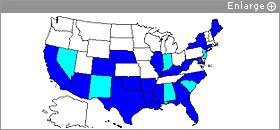Obesity is on the rise—worldwide and in the U.S. A new study, published by the Scientific American, found that there are now more overweight people than underweight people in the world, even in developing countries (“The World is Fat,” Scientific American, September, 2007). In the U.S., 14.8 percent of 10 to 17 year-olds are overweight or obese (“F as in Fat: How Obesity Policies are Failing in America,” Trust for America’s Health, 2007). Many public health experts point to rising obesity rates, and suggest that policy action is needed.
School food policies are among those that have come under great scrutiny. An expert panel from the Institute of Medicine advised federal officials to ban all junk food and soda in schools (“Ban Junk Food, Sodas in Schools, Prominent Scientists Recommend,” Education Week, May 2, 2007). Under mounting pressure from critics, the powerful beverage industry recently promised to voluntarily restrict its higher-calorie options in schools (“Fewer Sodas in School Vending Machines,” AP, September 17, 2007).
This Stat of the Week explores state policies that limit access to competitive foods in schools. The U.S. Department of Agriculture broadly defines competitive foods as all items not subsidized through federal school meal programs. Those items include food or beverages for sale at schools in a la carte lines, vending machines, or snack bars. Greater availability of competitive foods—often higher in fat or calories—tends to reduce overall fruit and vegetable consumption, a 2004 Government Accountability Office study reported.

Source: EPE Research Center, 2007. Data from “F as in Fat: How Obesity Policies are Failing in America,” Trust for America’s Health, 2007 and 2006.
In 2007, the Trust for America’s Health reported that 26 states had policies designed to reduce access to competitive foods and beverages in schools. Illinois, for example, prohibits the sale of all “confections, candy, and potato chips to students [in grade 5 or below] during meal periods.” Indiana code requires that “at least 50 percent of food [and beverage] items available for sale at a school or on school grounds must qualify as better choice foods or better choice beverages… Soft drinks, punch, iced tea, and coffee do not qualify as better choice beverages.”

Source: EPE Research Center, 2007. Data from “F as in Fat: How Obesity Policies are Failing in America,” Trust for America’s Health, 2007.
*1 = Highest rate of overweight children, 51 = lowest. Rankings are based on the National Survey of Children’s Health, a phone survey of parents with children ages 10-17 conducted in 2003-04 by the U.S. Department of Health and Human Services.
Trends suggest that the health of today’s generation of young people is threatened by lack of exercise and poor eating habits. Overweight and obese people are at risk for type 2 diabetes, heart disease, stroke, and some forms of cancer. In addition, the U.S. healthcare system suffers economic consequences from obesity-related illnesses. For more information on state education policies and childhood well-being indicators, please see the EPE Research Center’s Education Counts database.
